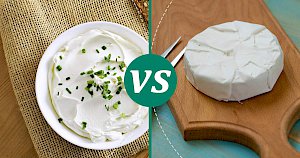Camembert vs Cream Cheese: Nutrition & Calories Compare


Camembert vs Cream cheese
Nutrition Facts
Serving size:
change
5g10g15g20g30g40g50g60g80g100g120g140g160g180g200g220g250g300g350g400g450g500g600g700g800g900g1000g
1oz2oz3oz4oz5oz6oz7oz8oz10oz12oz15oz20oz25oz30oz35oz40oz50oz
Amount Per Serving:
Serving size:
change
5g10g15g20g30g40g50g60g80g100g120g140g160g180g200g220g250g300g350g400g450g500g600g700g800g900g1000g
1oz2oz3oz4oz5oz6oz7oz8oz10oz12oz15oz20oz25oz30oz35oz40oz50oz
Amount Per Serving:
Camembert vs Cream Cheese 100g Compare
| per 100g | Camembert | Cream cheese |
|---|---|---|
| Calories | 300 | 350 |
| Carbohydrates | 0.46 g | 5.52 g |
| Fat | 24.26 g | 34.44 g |
| Protein | 19.8 g | 6.15 g |
| Water | 51.8 g | 52.62 g |
| Calcium | 388 mg | 97 mg |
| Iron | 0.33 mg | 0.11 mg |
| Magnessium | 20 mg | 9 mg |
| Potassium | 187 mg | 132 mg |
| Sodium | 842 mg | 314 mg |
| Vitaminium B1 (Thiamine) | 0.028 mg | 0.023 mg |
| Vitaminium B2 (riboflavin) | 0.488 mg | 0.23 mg |
| Vitaminium B3 (Niacin) | 0.63 mg | 0.091 mg |
| Vitaminium B6 | 0.227 mg | 0.056 mg |
| Vitaminium B9 (Folic acid) | 0.062 mg | 0.009 mg |
| Vitaminium E | 0.21 mg | 0.86 mg |
| Vitaminium K | 0.002 µg | 0.002 µg |
A Tale of Two Cheeses: Camembert vs. Cream Cheese
When it comes to cheese, the variety available can be overwhelming, each with its unique flavor, texture, and culinary uses. Among the plethora of options, Camembert and cream cheese stand out for their distinct characteristics and versatility. But what sets these two apart? Let’s delve into the fascinating world of these beloved cheeses, exploring not just their nutritional profiles but also their origins, uses, and why they continue to captivate cheese lovers worldwide.
What Makes Camembert So Special?
Originating from the lush landscapes of Normandy, France, Camembert is a soft, creamy cheese with a delicate, bloomy rind. Its history dates back to the late 18th century, and it has since become a symbol of French culinary heritage. Camembert’s rich, buttery flavor and smooth texture make it a favorite among cheese aficionados. It’s traditionally made from unpasteurized cow’s milk, although pasteurized versions are widely available. Camembert is not just a cheese; it’s a cultural icon, with a deep-rooted place in French cuisine and beyond.
Cream Cheese: A Versatile Favorite
Cream cheese, on the other hand, hails from the United States and quickly became a staple in kitchens around the world. Known for its mild, sweet taste and smooth, spreadable texture, cream cheese is made from cow's milk and cream. It owes its popularity to its incredible versatility, being a key ingredient in both savory dishes and desserts, from cheesecakes to frostings to bagel spreads. Unlike Camembert, cream cheese has a higher fat content and a more neutral flavor, making it a perfect canvas for a variety of flavor combinations.
Nutritional Overview
While both cheeses are beloved for their taste and texture, they offer different nutritional profiles. Camembert, with 300 calories per 100 grams, is slightly lower in calories than cream cheese, which has 350 calories per 100 grams. Camembert is also higher in protein, boasting 19.8 grams compared to cream cheese’s 6.15 grams, making it a more filling option. On the fat front, cream cheese takes the lead with 34.44 grams of fat, whereas Camembert contains 24.26 grams. However, it's worth noting that Camembert offers more in terms of minerals such as calcium, magnesium, and potassium.
Both cheeses contain minimal amounts of carbohydrates and sugar, making them suitable for low-carb diets, but those monitoring their sodium intake should be wary of Camembert’s higher sodium content. Despite these differences, both cheeses can find a place in a balanced diet, enjoyed in moderation.
Culinary Uses and Pairings
The culinary applications of Camembert and cream cheese are as diverse as their flavors. Camembert shines when served at room temperature, allowing its full flavor to unfold. It’s often enjoyed with a crusty baguette, fruits, or nuts, and it’s a staple on cheese boards. Camembert can also be baked to a gooey perfection, making it a decadent treat.
Cream cheese, with its creamy texture and mild flavor, is a versatile ingredient in both savory and sweet dishes. It’s the backbone of creamy dips, a key component in frosting recipes, and the essential ingredient in the beloved New York cheesecake. Its adaptability makes it a fridge staple in many households.
Conclusion: A Place for Both in the Cheese Pantheon
Choosing between Camembert and cream cheese depends on personal preference and culinary needs. Whether you’re drawn to the rich, earthy flavors of Camembert or the smooth, versatile nature of cream cheese, both cheeses offer unique qualities that can enhance a wide range of dishes. From elegant cheese platters to comforting home-cooked meals, Camembert and cream cheese hold their own as culinary champions, each with a storied history and a beloved place in the world of cheese.
Camembert 100g
300kcalCalories source
- 1% CARBS.
- 26% PROTEIN
- 73% FAT
Cream cheese 100g
350kcalCalories source
- 6% CARBS
- 7% PROTEIN
- 87% FAT
Compares of camembert
- Camembert vs Blue Cheese
- Camembert vs Brie
- Camembert vs Cottage Cheese
- Camembert vs Feta Cheese
- Camembert vs Gouda Cheese
- Camembert vs Butter
- see all compares of camembert
Compares of cream cheese
Read also:
- Calories from Camembert
- Calories of Coconut oil
- Calories in Sousage
- Almond butter calories per 100g
- Trout protein per 100g
- How many calories does atlantic salmon have?
- Calories in a half of dragon sushi roll
- Calories in whole dragon sushi roll
- Calories for one, two or more dragon sushi rolls
- How much protein in california burrito?
Marcin Piotrowicz
calories-info.com creator
Healthy diet and healthy lifestyle promoter
Add comment